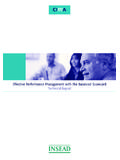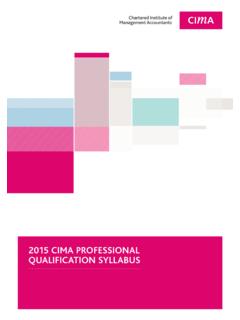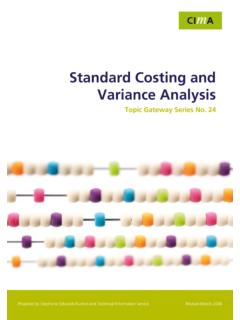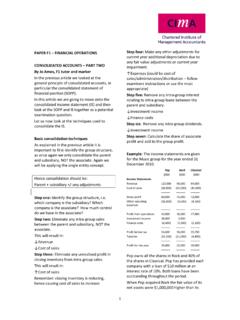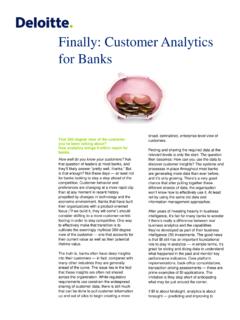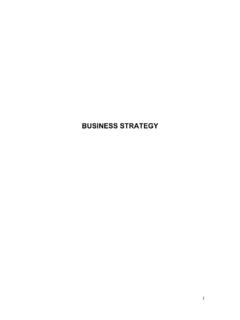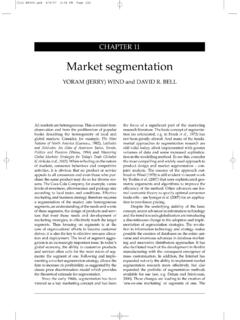Transcription of Customer Profitability Analysis Topic Gateway
1 Topic Gateway Series Customer Profitability Analysis 1 Prepared by Jasmin Harvey and Technical Information Service January 2009 Customer Profitability Analysis Topic Gateway Series No. 55 2 Customer Profitability Analysis Topic Gateway Series About Topic Gateways Topic Gateways are intended as a refresher or introduction to topics of interest to CIMA members. They include a basic definition, a brief overview and a fuller explanation of practical application. Finally they signpost some further resources for detailed understanding and research. Topic Gateways are available electronically to CIMA members only in the CPD Centre on the CIMA website, along with a number of electronic resources.
2 About the Technical Information Service CIMA supports its members and students with its Technical Information Service (TIS) for their work and CPD needs. Our information specialists and accounting specialists work closely together to identify or create authoritative resources to help members resolve their work related information needs. Additionally, our accounting specialists can help CIMA members and students with the interpretation of guidance on financial reporting, financial management and performance management, as defined in the CIMA Official Terminology 2005 edition. CIMA members and students should sign into My CIMA to access these services and resources. The Chartered Institute of Management Accountants 26 Chapter Street London SW1P 4NP United Kingdom T.
3 +44 (0)20 7663 5441 F. +44 (0)20 7663 5442 E. Customer Profitability Analysis Topic Gateway Series 3 Definition and concept Customer Profitability Analysis (CPA) is the: Analysis of the revenue streams and service costs associated with specific customers or Customer groups. CIMA Official Terminology 2005 Kotler (1997) defines a profitable Customer as: A person, household or company that, over time, yields a revenue stream that exceeds by an acceptable amount the company s cost stream of attracting, selling and servicing that Customer . The CIMA definition does not provide any guidance as to when the Analysis of Customer Profitability should be undertaken. Good practice suggests that this Analysis is undertaken over the lifetime of customers, so that a Customer Lifetime Value (CLV) can be obtained.
4 This is calculated on the basis that the Profitability of customers can vary significantly over the life of their relationship to a company. Context In the current syllabus, students will learn about and may be examined on Customer Profitability Analysis (CPA) in P6 Management Accounting, Business Strategy. Related concepts Activity based costing; attribute costing; Customer lifetime value (CLV); Customer value. Customer Profitability Analysis Topic Gateway Series 4 Overview CPA is an important management accounting tool based on the recognition that each Customer is different. Therefore each dollar of revenue or each dollar of cost generated by the Customer does not contribute equally to a company s Profitability .
5 CPA s value lies in its ability to improve strategic decision making. In their book Killer customers: tell the good from the bad and crush your competitors, Selden and Colvin estimate that the top 20% of customers (by Profitability ) generate more than 120% of an organisation s profits. Meanwhile, the bottom 20% generate losses equalling more than 100% of profits. CPA can be used to work out which customers comprise the top 20% (and the bottom 2%). It can also be used to help companies to understand: how dependent they are on the most profitable customers what proportion of resources are used for different customers the full cost of servicing a Customer including advertising, service and returns which customers are targeted by competitors.
6 Application Customer Profitability Analysis - approach The general approach to CPA is based on segmenting the Customer base to determine the revenues and costs attributable to each segment. This is often combined with an activity-based costing (ABC) approach. Once the profitable and non-profitable segments are identified, profitable segments are maximised while non-profitable segments are reduced or eliminated. Each of the key steps in this process is outlined below. Step 1 Customer segmentation The basis for Customer segmentation will differ across companies and across industries. Currently, there are two basic approaches to Customer segmentation : 1. Demographic segmentation based on observable characteristics such as geographic area, Customer age, sex and income level.
7 2. Psychographic segmentation based on Customer needs and behaviour such as Customer values, attitudes and interests. Source: Sarvary and Elberse, (2006) Customer Profitability Analysis Topic Gateway Series 5 Step 2 Revenue attributable to each segment Once segments have been identified, the annual revenue is calculated per segment, how this is done will depend on the products or services offered by the company. Adjustments to the price paid by the Customer for a product or service, such as discounts, service fees or product enhancement fees, must be included to determine the true amount of revenue generated by each Customer and the aggregated amount calculated for the Customer segment.
8 Step 3 Use ABC to determine the cost attributable to each segment The annual cost is calculated per segment. This will involve both directly attributable product or service costs and also Customer costs, including allocation of overheads, marketing, sales and distribution costs. It is these Customer costs which are often hidden, such as quality control and inspection costs, order picking, order fulfilment and Customer ordering costs. ABC is an effective way to assign both types of costs to customers. You can learn or familiarise yourself with ABC by referring to the Topic Gateway on this subject. It is available from: [Accessed 24 November 2008] Step 4 Analyse the profitable versus the less profitable or unprofitable Customer segments The profitable Customer segments will be those whose annual revenues exceed annual costs.
9 As the Profitability of Customer segments is likely to vary from year to year, a more accurate Analysis could involve calculating Profitability over the lifetime of each Customer segment, as noted below. Step 5 Develop strategies to maximise profits from profitable customers and reduce or eliminate less profitable or non-profitable customers For profitable Customer segments, this step involves detailed planning around the development of long term Customer relationships for increased revenues, and hence Profitability such as Customer retention and loyalty programmes. To address the least profitable or non-profitable Customer groups, two main actions are used [Botten, N. 2007]. 1. Elimination ceasing to supply these customers.
10 This can be done by no longer marketing to these customers, changing the product or service so that it is no longer suitable, or raising prices. Customer Profitability Analysis Topic Gateway Series 62. Re-engineering turning the least profitable or non-profitable Customer groups into profitable ones by either increasing revenue or decreasing costs attributable to these groups, or both. Examples include charging additional fees for services or using differential prices, according to Customer segment. Step 6 Review the impact of the new strategies on the performance of the Customer segments The implementation of any new strategy, for example, changes in pricing, cost reduction or Customer service, should be reviewed after an appropriate period to determine the impact on Customer Profitability .

